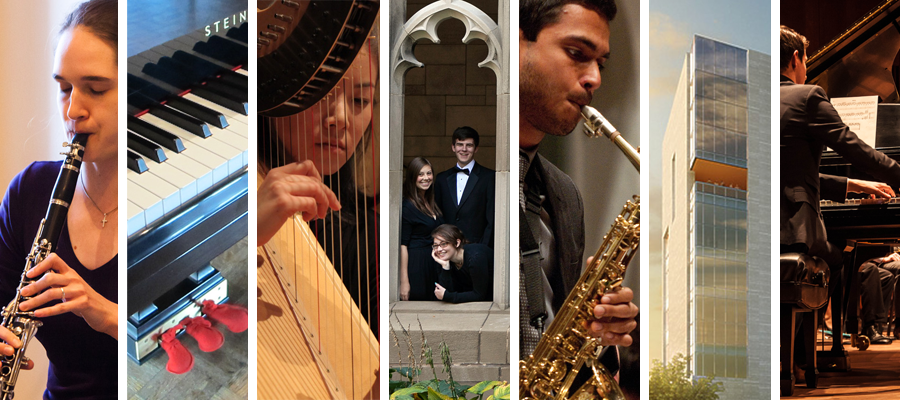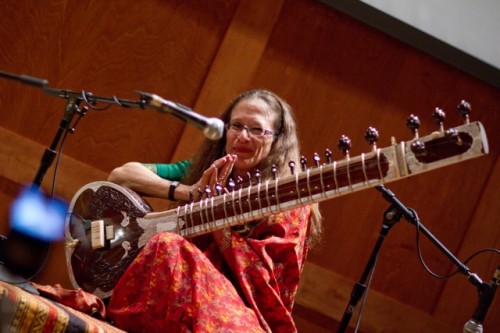Interview with Kaley Mason, Assistant Professor of Music
Monday, February 11th begins a FREE weeklong series of events in multiple locations across campus when The South Asian Sound Interventions Series presents “Performing the Bengal Borderlands: Music, Movement, and Encounter.” What is the back-story behind this exciting, five-day event?
“Performing the Bengal Borderlands,” a SASI weeklong series of workshops, performances, academic papers, screenings, and roundtables beginning on February 11, grew out of an earlier program organized around the short-term residencies of Bangladeshi Boyati bardic singer Momtaz Begum and bamboo flautist Jalal Ahmed. Due to visa delays, we rescheduled and revised the program with an equally distinguished set of invitations, including Dallas-based sitarist, ethnomusicologist, and documentary filmmaker Amie Maciszewski, Kolkata-based sarodist and instrument curator Somjit Dasgupta, Illinois-based tabla artist Manpreet Bedi and Dhaka-based playwright, folklorist, and scholar Saymon Zakaria. With the support of faculty in the Department of South Asian Languages and Civilizations and our sponsors, including the Franke Institute for the Humanities, the University of Chicago Arts Council, and the Committee on Southern Asian Studies, we have planned a compelling week of events highlighting musical traditions, instruments, and scholarship from the Northeastern region of India and neighboring Bangladesh. The focus on this particular international region complements the current research interests of faculty and ethnomusicology graduate students, including the work of Bertie Kibreah, Rehanna Kheshgi, Philip Bohlman, and Thibaut d’Hubert, among others. It also coincides with the opening of the SMART Museum exhibit, The Sahmat Collective: Art and Activism in India since 1989, on February 14.
(SASI website)
Can you talk a bit about the musical focus of the guest artists for this series? What musical styles can audience members expect to hear?
The music will range from Hindustani North Indian classical compositions for plucked string instruments like the sitar and the sarod, to vernacular (folk) Bangla and Assamese song repertories from India and Bangladesh. In addition to listening to performances on the harmonium, tabla, and bowed esraj, we can expect to learn from documentaries about the art of crafting instruments as well as the use of popular, devotional, and semi-classical genres as resources for empowering hereditary women performers in the struggle against social exclusion and sexual exploitation. Lastly, on Friday, February 15, everyone will have an opportunity to perform within a South Asian musical frame of reference at a participatory mahfil: an Urdu term for an evening gathering of intimate music making and appreciation of the performing arts. Bring your instrument and/or musical sensibility!
The music of South Asia has recently made a resurgence at the University of Chicago. With the growth and development of the South Asian Sound Intervention Series, students, staff, and community members now have greater access to the vast array of music from this area of the world and I understand that you have been at the forefront of making this possible. Can you tell me about the process of bringing in these special repertory professional ensembles? What are some of the challenges in doing so?
First, I should distinguish between South Asian Sound Interventions (SASI) and the South Asian Vocal Ensemble (SAVE). SASI is a performing arts initiative aimed at creating a series of pedagogical engagements with professional artists who work within and beyond the canonic traditions of the Indian subcontinent. The graduate student and faculty organizers of SASI seek out innovative performers who challenge aesthetic and socio-musical norms in their respective vernacular, popular, or classical musical traditions. Since SASI began in 2011, the series has been jointly sponsored by the Committee on Southern Asian Studies and the Department of Music. The program has featured Pune-based Hindustani violinist Vidya Dengle (October 2011), Chicago-based Bengali tabla artist Sandip Burman (December 2011), South Indian film music director/producer duo Jassie Gift and Vijay Jacob (February 2012), our own Kuchipudi dancer/scholar PhD alumna Rumya Putcha (April 2012, currently visiting assistant professor at Earlham College), and Portland-based sitarist Josh Feinberg (November 2012). Each artist combined performance with pedagogy in workshops and interactive performances.
SAVE, by contrast, is now an official departmental ensemble that meets Monday 4:30-7 throughout the academic year. It began in the spring quarter of 2012 as a weekly workshop offering regular instruction in a variety of classical, vernacular, and popular song repertories from the Indian Subcontinent. Membership was open to beginners as well as to more experienced performers with a background in South Asian music. A recital showcasing some of the repertoire learned through the workshop was held on Memorial Day at Fulton Recital Hall. In the fall of 2012, the workshop became an ensemble under the direction of Ms. Minu Pasupathi, a prominent local classically trained singer. While Ms. Pasupathi has since primarily focused on teaching vocal techniques, stylistic features, compositional forms, improvisational practices, and performance conventions in the South Indian Karnatik Classical tradition, she embraces a variety of musical styles specific to India, Pakistan, Afghanistan, Bangladesh, Nepal, Sri Lanka, and South Asian diasporas. Most musical training in India begins and unfolds concurrently with voice pedagogy, which is why it is not only less expensive to begin with a vocal ensemble, but also culturally and musically appropriate. As anticipated, more experienced members of the ensemble have already begun adding instrumental support in the form of melodic and rhythmic accompaniment on the sitar, harmonium, and mridangam.
Finding the right instructor to lead the ensemble was by far the greatest challenge. Ms. Minu Pasupathi has been teaching Karnatak (South Indian classical) music for over a decade in Chicago. She has an MA in Music from the University of Chennai (the most distinguished center for classical music training in South India) and she currently runs Akshaya Music Academy in Schaumburg. She is a distinguished performer who gives recitals regularly at Indian music festivals and Chicago’s Hindu temples. But more importantly, she has the rare combination of rigorous training in the master-disciple classical tradition and the ability to teach participants from different musical backgrounds within a Western institutional framework. This profile is not easy to find! We were very lucky: a) to have found her relatively early in our search; b) that she has been willing to make the weekly trip in traffic from the Northwestern suburbs; and c) that we have in Rehanna Kheshgi a graduate student coordinator who has the musicality, area expertise, organizational acumen, and enthusiasm necessary to help establish the ensemble. Ms. Pasupathi is currently working with Rehanna on the spring recital program scheduled for Saturday evening, May 11, at Fulton Recital Hall. In the future, we look forward to collaborating with Rockefeller Chapel (Diwali program), Apsara (a dynamic RSO dedicated to the practice, discussion, and performance of Indian classical dance styles), and the Middle East Music Ensemble.
One of the most recently formed ensembles in the Department of Music is the South Asian Vocal Ensemble. What unique contributions does this ensemble make to our University? For example, do they offer a different perspective that is particularly valuable to students?
There is a growing constituency of students and faculty across the University community interested in studying South Asian music as a co-curricular and research-related practice. Moreover, the Reva and David Logan Center has expressed interest in expanding performing arts programming to include more world music in the form of regular ensemble activities and special events. Lastly, with the inauguration of the Delhi Center on the horizon (2013-2014), this is a timely moment to add a South Asian option to our performance program. There have already been inquires about the possibility of engaging members of the ensemble to perform at the Center’s official opening.
You are currently working on a book “that traces movement-driven themes like migration, radical socialism, and religious pluralism across multiple popular music scenes in South India and its diasporas in the American Midwest and the Middle East.” How do your current, scholarly interests intersect with the classes that you teach here at the University?
My current research project examines the relationship between radical socialism and song in South India popular music scenes since Indian Independence. In 1956 the first democratically installed communist government was elected in the southwestern Malayalam-speaking state of Kerala. While political scientists, historians, and sociologists have attempted to explain this from their respective disciplinary vantage points, few scholars have investigated the role music and the arts played in galvanizing popular support for left-leaning parties. The composers and lyricists who wrote commercial film songs in the 50s and 60s drew from a long tradition of voicing social commentary in song through street theater. There appears to be enough evidence to suggest that without the affective appeal of film songs with socialist lyrical themes, the Communist Party of India might never have gained the traction it needed to form the first state government. From popular film music directors to alternative rock bands, many Malayalam popular music artists continue to amplify Marxist-inspired ideologies in songs addressing contemporary social problems. In light of my research focus on intersections of song, affect, mobility, and politics, I recently offered a graduate seminar on music and social movements.
Interview by Julia Tobiska

